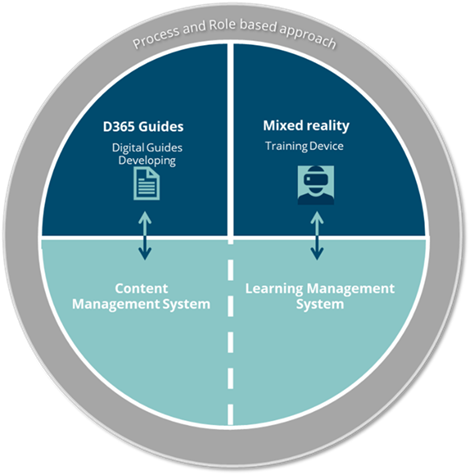Increase your training efficiency, reduce onboarding time, provide relevant training, and document it at the same time.
Traditional training methods based on extensive SOPs often prove ineffective and impractical, especially if used alone, leaving employees struggling to execute their jobs correctly and efficiently. Enabling new joiners and upskilling the existing workforce with the necessary skillset can be challenging, while at the same time, skilled and competent employees are essential to success. In this article, we invite you to explore how NNIT can support you in revolutionizing your training practices and transforming them for the 21st century with Mixed Reality. Our concept goes beyond tick-box compliance, prioritizing a training quality that is immersive, relevant, and aligned with real-world scenarios instead.
The constantly increasing demands in the life science industry, whether they relate to getting faster to market or delivering cost-effective and high-quality products, all affect the people in the organization. Despite the obvious challenges, many companies continue to operate with poor training programs. These programs prioritize generating proof of compliance over delivering an effective learning experience that grows and expands competencies in the organization. This often leaves employees with an overload of long and complex documents to read, disconnected from their actual jobs, and often assigned long before the job execution.
Recognizing and implementing effective learning techniques is imperative for successful learning. Some research indicate that different learning techniques have very different effects in terms of knowledge retention. Studies found that on average, people remember about 10% of what they read from textbooks but retain around 75% of what they learn through practice by doing. Some learning techniques are more effective than others, and it was also found that using a variety of techniques can result in even deeper learning and longer retention. Combining different learning techniques with microlearning makes the training even more efficient. Microlearning entails learning new information in small chunks of short duration. This further improves retention, flexibility, and productivity, leading to more efficient training and skilled and competent employees.
Mixed Reality devices such as HoloLens support several learning techniques and provide an active and multisensory learning approach. The devices offer a comprehensive range of features that supports the blended learning processes by enabling a combination of physical and virtual information and objects that coexist and interact with each other. The information can be both visual and auditive and requires physical activity. This also implies that the use of mixed reality devices is not for all training situations, and an assessment of why and when it is relevant is needed.
Incorporating multiple senses into learning significantly enhances information retention and improves skill memorization. Moreover, it empowers organizations to effectively engage all employees, regardless of their learning styles and cognitive preferences. Integrating Mixed Reality devices presents a compelling opportunity to develop robust Blended Learning curriculums that embrace multisensory learning and different learning techniques, ultimately giving a better and safer training environment.
NNIT’s 21st century training concept consists of three components. The first component is a quality platform – a content management system (CMS) and a learning management system (LMS). The CMS manages documents in traditional formats such as Word, PDF, and PowerPoint but also data such as Web content and digital assets e.g., images, audio, and video files. The CMS could be Veeva Quality Docs, and the LMS could be Veeva Training. These applications are unified on a single cloud platform and are part of the Veeva Suite. The concept is fully integrated with the Veeva Quality Suite. Having CMS and LMS unified on a single platform gives learners easy access to content to complete training tasks. A centralized view of training across the entire organization helps track training completion, ensure compliance with training requirements, and minimize errors and deviations caused by inadequate training.
The second component consists of the Mixed reality device, as described above, and Microsoft D365 guides, which are the digital guides used through the HoloLens. The last component is the process- and role-based approach, combining all elements of the training process to ensure compliance, relevance, and efficiency. By considering specific roles, we leverage a blended learning toolbox to select appropriate methodologies for optimal learning outcomes. This approach customizes the training to address the unique skills, knowledge, and competencies needed for each role, ensuring individuals receive targeted training that enhances their performance and improves their ability to fulfill their responsibilities effectively.
NNIT’s 21st century training concept, successfully implemented in the life science industry, is a mature and GxP-compliant approach. It supports employees throughout their training journey, starting from new hires to ongoing development, with a dedicated emphasis on adapting and enhancing knowledge and skills. By increasing training efficiency and significantly enhancing the training experience, this concept also drives improved business performance. It has the potential to increase training efficiency by up to 60%, reduce rework by up to 50%, and significantly improve user experience and satisfaction. Furthermore, this concept enables life science companies to reduce onboarding time, expediting employee readiness for various tasks, including on-the-job training, support, and job rotation.
Our concept empowers companies to easily evaluate, demonstrate and document their employees’ competencies and qualifications as it provides the opportunity to record the training and sign off in the Veeva Training application directly through the HoloLens.
Once the investment has been made, you can expand and maximize the outcome. A HoloLens is a general-purpose device that can be used for much more than training and allows you to scale your expert knowledge through different kinds of remote collaboration. NNIT offers guidance for several other use cases such as remote audit, remote inspection, or remote assistance, allowing employees access to experts any time they need it.
Ready to transform your training experience for the 21st century and take your organization to new heights? Contact us today to learn how we can revolutionize your training programs and empower your team with enhanced skills and knowledge. Getting started is easy – simply reach out to us, and our expert team will guide you through the process. You might also want to try the HoloLens.
Do not miss out on the opportunity to unlock the full potential of your organization. Take the first step towards a remarkable training transformation by contacting us now!



